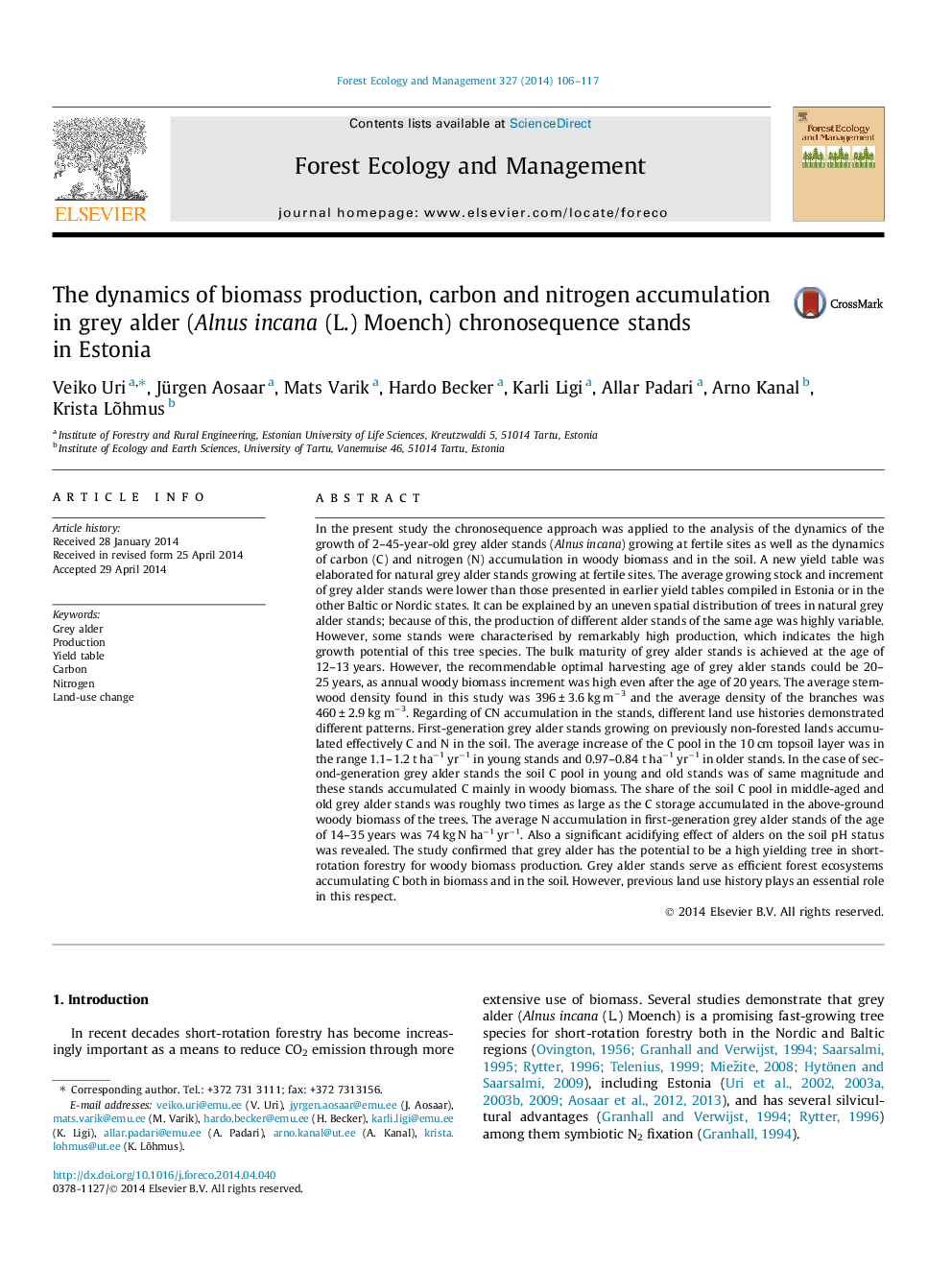| کد مقاله | کد نشریه | سال انتشار | مقاله انگلیسی | نسخه تمام متن |
|---|---|---|---|---|
| 6543478 | 159197 | 2014 | 12 صفحه PDF | دانلود رایگان |
عنوان انگلیسی مقاله ISI
The dynamics of biomass production, carbon and nitrogen accumulation in grey alder (Alnus incana (L.) Moench) chronosequence stands in Estonia
دانلود مقاله + سفارش ترجمه
دانلود مقاله ISI انگلیسی
رایگان برای ایرانیان
کلمات کلیدی
موضوعات مرتبط
علوم زیستی و بیوفناوری
علوم کشاورزی و بیولوژیک
بوم شناسی، تکامل، رفتار و سامانه شناسی
پیش نمایش صفحه اول مقاله

چکیده انگلیسی
In the present study the chronosequence approach was applied to the analysis of the dynamics of the growth of 2-45-year-old grey alder stands (Alnus incana) growing at fertile sites as well as the dynamics of carbon (C) and nitrogen (N) accumulation in woody biomass and in the soil. A new yield table was elaborated for natural grey alder stands growing at fertile sites. The average growing stock and increment of grey alder stands were lower than those presented in earlier yield tables compiled in Estonia or in the other Baltic or Nordic states. It can be explained by an uneven spatial distribution of trees in natural grey alder stands; because of this, the production of different alder stands of the same age was highly variable. However, some stands were characterised by remarkably high production, which indicates the high growth potential of this tree species. The bulk maturity of grey alder stands is achieved at the age of 12-13 years. However, the recommendable optimal harvesting age of grey alder stands could be 20-25 years, as annual woody biomass increment was high even after the age of 20 years. The average stemwood density found in this study was 396 ± 3.6 kg mâ3 and the average density of the branches was 460 ± 2.9 kg mâ3. Regarding of CN accumulation in the stands, different land use histories demonstrated different patterns. First-generation grey alder stands growing on previously non-forested lands accumulated effectively C and N in the soil. The average increase of the C pool in the 10 cm topsoil layer was in the range 1.1-1.2 t haâ1 yrâ1 in young stands and 0.97-0.84 t haâ1 yrâ1 in older stands. In the case of second-generation grey alder stands the soil C pool in young and old stands was of same magnitude and these stands accumulated C mainly in woody biomass. The share of the soil C pool in middle-aged and old grey alder stands was roughly two times as large as the C storage accumulated in the above-ground woody biomass of the trees. The average N accumulation in first-generation grey alder stands of the age of 14-35 years was 74 kg N haâ1 yrâ1. Also a significant acidifying effect of alders on the soil pH status was revealed. The study confirmed that grey alder has the potential to be a high yielding tree in short-rotation forestry for woody biomass production. Grey alder stands serve as efficient forest ecosystems accumulating C both in biomass and in the soil. However, previous land use history plays an essential role in this respect.
ناشر
Database: Elsevier - ScienceDirect (ساینس دایرکت)
Journal: Forest Ecology and Management - Volume 327, 1 September 2014, Pages 106-117
Journal: Forest Ecology and Management - Volume 327, 1 September 2014, Pages 106-117
نویسندگان
Veiko Uri, Jürgen Aosaar, Mats Varik, Hardo Becker, Karli Ligi, Allar Padari, Arno Kanal, Krista Lõhmus,